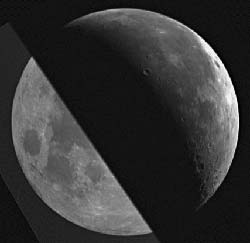Scientists look at moon to shed light on Earth’s climate

<b>Researchers Look at Moon for Climate Answers</b> <br>This composite image of the dark side’s Earthshine (left of image) and bright side’s Moonshine (right of image) illustrates what scientists are looking at. Researchers used a blocking filter to dim the Moonshine crescent, typically about 10,000 times brighter than Earthshine. <br>Credit: BBSO/NJIT
According to a new NASA-funded study, insights into Earth’s climate may come from an unlikely place: the moon.
Scientists looked at the ghostly glow of light reflected from Earth onto the moon’s dark side. During the 1980s and 1990s, Earth bounced less sunlight out to space. The trend reversed during the past three years, as the Earth appears to reflect more light toward space.
Though not fully understood, the shifts may indicate a natural variability of clouds, which can reflect the sun’s heat and light away from Earth. The apparent change in the amount of sunlight reaching Earth in the 1980s and 1990s is comparable to taking the effects of greenhouse gas warming since 1850 and doubling them. Increased reflectance since 2001 suggests change of a similar magnitude in the opposite direction.
Researchers from the New Jersey Institute of Technology (NJIT), Newark, N.J., and California Institute of Technology (Caltech), Pasadena, Calif., combined NASA cloud data from satellites with records of Earth’s reflectance off the moon, called earthshine. The study, funded by NASA’s Living With a Star Program, appears May 28 in the journal Science.
“Using a phenomenon first explained by Leonardo DaVinci, we can provide valuable data on the overall reflectance of the Earth, and indirectly, on global cloud cover,” said Phil Goode, a physicist at NJIT, one of the paper’s authors. He is director of Big Bear Solar Observatory (BBSO), Big Bear City, Calif. “Our method has the advantage of being very precise, and light reflected by large portions of Earth can be observed simultaneously,” he said.
Recent news reports suggested sunshine reaching Earth declined from the late 1950s to the early 1990s. This new study suggests the opposite. Earth’s surface may have been sunnier, or less cloudy, in the 1980s and 1990s. BBSO has conducted precision earthshine observations since 1994. Regular observations began in late 1997.
The research team improved upon an old method for monitoring earthshine. They compared earthshine measurements from 1999 to mid-2001 with overlapping satellite observations of global cloud properties. The cloud satellite record from 1983 to 2001 came from the NASA-managed International Satellite Cloud Climatology Project. By matching these two records, the researchers used the cloud data to extend the record and construct a substitute measure of Earth’s albedo, the fraction of light reflected by a body or surface.
The data showed a steady decrease in Earth’s albedo from 1984 to 2000. Between 1995 and 1996, Earth dimmed even more sharply. The data were consistent with satellite measurements of changing global properties. From 1997 to 2000, Earth continued to dim. The researchers suggest, during this time period, the decreases in Earth’s reflectance may be related to an observed accelerated increase in mean global surface temperatures. From 2001 to 2003, Earth brightened to pre-1995 values. The researchers attributed the brightening to changes in cloud properties.
“At the moment, the cause of these variations is not known, but they imply large shifts in Earth’s radiative budget,” said co-author Steven Koonin, a Caltech physicist. “Continued observations and modelling efforts will be necessary to learn their implications for climate.”
The research offers evidence Earth’s average albedo varies considerably from year to year, and from decade to decade. “Our most likely contribution to the global warming debate is to emphasize the role of clouds in climate change must be accounted for, illustrating that we still lack the detailed understanding of our present and past climate system to confidently model future changes,” said Enric Palle, a postdoctoral associate at NJIT, lead author of the paper. Pilar Montan~es-Rodriguez, a postdoctoral associate at NJIT, is another co-author.
“Even as the scientific community acknowledges the likelihood of human impact on climate, it must better document and understand climate changes,” Koonin said. “Our ongoing earthshine measurements will be an important part of that process.”
BBSO, operated by NJIT, is partially supported by NASA. NASA’s Living with a Star Program develops the scientific understanding necessary to effectively address those aspects of the connected sun-Earth system that directly affect life and society.
Media Contact
More Information:
http://www.gsfc.nasa.gov/topstory/2004/0528earthshine.htmlAll latest news from the category: Earth Sciences
Earth Sciences (also referred to as Geosciences), which deals with basic issues surrounding our planet, plays a vital role in the area of energy and raw materials supply.
Earth Sciences comprises subjects such as geology, geography, geological informatics, paleontology, mineralogy, petrography, crystallography, geophysics, geodesy, glaciology, cartography, photogrammetry, meteorology and seismology, early-warning systems, earthquake research and polar research.
Newest articles

Parallel Paths: Understanding Malaria Resistance in Chimpanzees and Humans
The closest relatives of humans adapt genetically to habitats and infections Survival of the Fittest: Genetic Adaptations Uncovered in Chimpanzees Görlitz, 10.01.2025. Chimpanzees have genetic adaptations that help them survive…

You are What You Eat—Stanford Study Links Fiber to Anti-Cancer Gene Modulation
The Fiber Gap: A Growing Concern in American Diets Fiber is well known to be an important part of a healthy diet, yet less than 10% of Americans eat the minimum recommended…

Trust Your Gut—RNA-Protein Discovery for Better Immunity
HIRI researchers uncover control mechanisms of polysaccharide utilization in Bacteroides thetaiotaomicron. Researchers at the Helmholtz Institute for RNA-based Infection Research (HIRI) and the Julius-Maximilians-Universität (JMU) in Würzburg have identified a…



